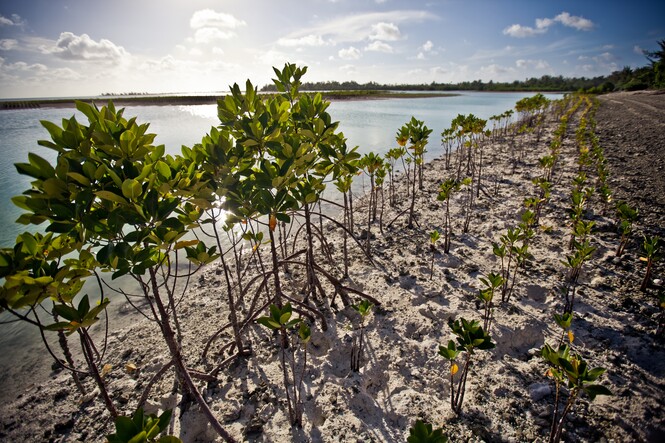
Working with nature-based solutions can prevent exposure to these hazards and support vulnerable communities in adapting to, and withstanding, the impacts of climate change.
However, the window to implement these life-saving adaptations measures is slowly closing. If we miss this window, nature will reach hard adaptation limits where it cannot adapt to climate impacts and damage will become unavoidable – it can no longer serve as our natural barrier to protect people from flooding, storm-surge, droughts and heatwaves.
Laws, policies and plans can enable the implementation of nature-based solutions by establishing positive obligations to protect nature, government mandates for conservation, sustainable management and restoration of nature, as well as defining roles, rights and responsibilities of those involved.
The multiple benefits of mangrove restoration: Lessons from Viet Nam
In Viet Nam, massive conversion of coastal mangroves into rice fields and aquaculture from the 1980s to 1990s, as well as urban development and war, increased the exposure of coastal infrastructure and livelihoods to typhoons and storm surges. Sea dykes, aquacultures, and rice farming along the coastline were damaged and lost as a result.
To combat the loss of natural coastal protection, Viet Nam Red Cross (VNRC) launched the Mangrove Plantation and Disaster Risk Reduction (MP-DRR) project in 1994 to safeguard sea dykes, reduce flooding risk and protect livelihoods. The project began as a pilot in five communities in Thai Binh province focused on planting mangroves.
As part of this project, VNRC and partners increased communication and advocacy to change the minds of policymakers to improve forest laws on mangrove and coastal forest management. This has led to increased recognition of the importance of mangrove protection and restoration as a national priority.
The government has introduced several policies focused on achieving coastal forest conservation and restoration and penalising deforestation, including a decree in 2016 to provide for policies on sustainable management, protection and development of coastal forests to respond to climate change. Amongst others, the decree sets obligations; provides budget support for the management, protection and development of coastal forests; and provides guidance on land allocation.
The involvement of the local community, in particular women and children, was a critical dimension of project implementation. The project engaged vulnerable people in planting, protecting and restoring the mangroves, including the local community who depend on mangroves for their livelihoods.
The VNRC planted millions of native species of mangroves that were adapted to the local climate and provided a diverse habitat for coastal wildlife. Mangroves planted and protected by VNRC and communities are currently covering approximately 9,000 hectares. VNRC and communities continue to take care of mangroves, in many cases with support of local government.
The larger coastal mangrove area has resulted in more protection against storm surges and typhoons. The project also contributes to climate change mitigation, the value of estimated minimum CO2 emissions absorbed by the planted mangroves stands at US$218 million.
This nature-based solution, led by Viet Nam Red Cross and the community and supported by the government, has helped reduce the effect of weather-related disasters, create new habitats for wildlife and plants and protect livelihoods.
Read more about the benefits of mangrove restoration in Viet Nam here.